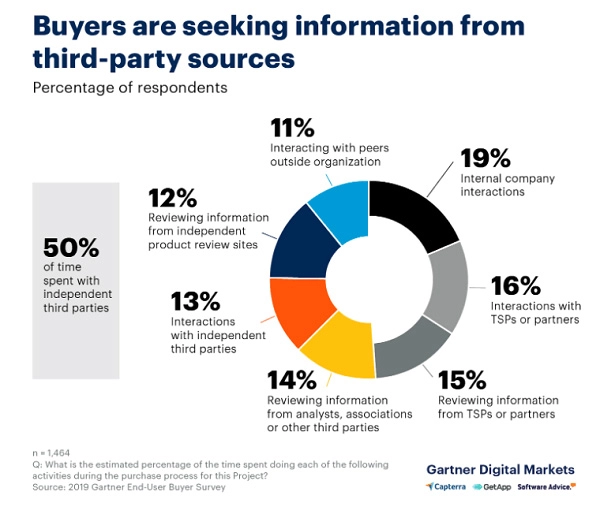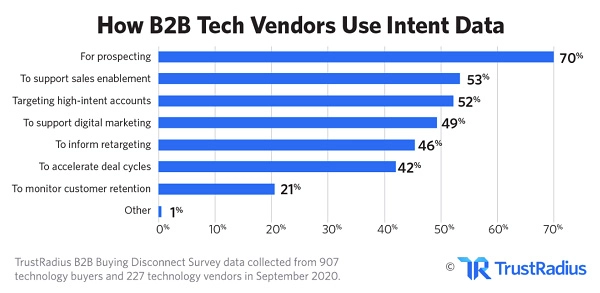
Introduction
Imagine a scenario where you can pull out data of your prospective customers rigorously hunting for a product similar to (or just like) what you offer.
What if we say that’s possible? Intent data is what gives you that capability, if only you use it.
Field sales suddenly came to a halt in 2020—buyers had to shop online. But then, no customer buys the first thing they see online.
According to research by Salesforce and Publicis Sapient, 87% of shoppers make it a habit to research a product online before they make a purchase.
They look for and compare similar products, read relevant content, and watch videos that address their requirements or pain points.
What’s concerning is that they aren’t asking your sales team for help. Most customers finish their buyer’s journey without even engaging with a salesperson.

Image source: Gartner End-User Buyer Survey
Let’s break the curse and get you ahead of the process by helping you nurture your enterprise tech audience.
What is Intent Data
Intent data is digital prospecting information that shows which leads or accounts are actively researching on third-party sites. This behavioral pattern can help identify potential hot, ready-to-buy prospects.
Leads and accounts that show an increase in interest around topics related to your products or services are identified as “in-market” intent monitoring data.
When these leads research specific products, seasonality, or trends, they have displayed a higher than usual interest in your product or service.
Such data helps you understand your clients’ needs and get ahead of their requests. You get to keep note of what topics are your customers researching via mediums like:👇
- General articles
- Published news
- Product reviews
- Product comparisons
- Infographics and blogs
- Case studies
- Press releases
A new report from TrustRadius suggests that only 40% of software companies use intent monitoring for lead generation. This is a wasted opportunity for software marketers.
“Intent data isn’t just good to have, it’s necessary for digital marketers. However, it seems like few are getting on board –– or don’t even know what to do with it, or where to get it from.”
How is Intent Data Collected
Intent monitoring data are of two types, and they come from a diverse set of sources.
1. Internal Data (First-Party Data)
As the name suggests, internal intent is collected in-house, mostly with the help of a marketing automation platform. If you run a web app, you can also collect it from application logs.
There are two kinds of data here: anonymous and known data.🧐
Anonymous Data: For example, a person has visited your website but did not download anything or fill any form. However, you have the IP address of the company where this person works. That’s anonymous data.
Know Data: For example, a person has visited your website and downloaded an e-book or guide. Here the info you have is known data.
“The benefit of collecting both types of intent data is that you can collect it yourself.”
You have control over how you collect it. Consequently, you can customize what you want to classify as purchase data.
2. Third-Party Data
Third-party data is collected from third-party website visits and downloads.
In this case, too, you get two kinds of data: Known Data (when someone fills a form or downloads something deliberately) and Anonymous Data (when someone only visits the website but does not download anything).
Many companies sell third-party intent data, and sometimes, they enter into partnerships with other companies to offer their target market better products.
How are Marketers Driving Revenue with Intent Data
Of the 40% of companies that utilize intent monitoring, 70% use it for prospecting. Because the majority of buyer research takes place online before a prospect ever speaks with a sales agent, this is an obvious use case. Other use cases by successful marketers include:

Image Source: TrustRadius
But it’s also important to realize that there are other ways intent monitoring can be used. Some companies are using it to qualify sales leads more quickly. Others are using it to create a new, intelligent persona.
Let’s take a look at those too.👇
- Identify buyers: With intent signals, you can identify who your product or services would be the most profitable to sell to.
- Personalization: Marketing can be effective by having the right resources to make initial outreach. With personalization, you can offer the right resources to match whatever requirements your prospects are looking for. Besides, successful Account-Based Marketing campaignsare also built on personalization.
- Prioritizing accounts: You get the liberty to prioritize accounts and work on the ones they have shown interest in.
- Boost outbound sales: It lets your sales team reach out to qualified leads in your buying cycle instead of wasting time on cold emails to the wrong people.
Intent monitoring can help you make B2B content syndication more effective. You can see when your target audience is researching a similar product or service and give them a piece of valuable information or a call to action that will lead them to your business.
How to Choose a Good B2B Intent Data Provider: 6 Questions to Ask
By now, you know that intent monitoring offers a deeper, more meaningful understanding of your leads, prospects, and customers.
“While the concept is relatively new, more B2B organizations are inclining towards its unique benefits.”
Over a third of all B2Bs claim that using data is the most difficult obstacle when it comes to improving the customer experience. Misleading, incorrect data is the last thing you need.
The good news is that many companies have sprung up to provide the best possible intent monitoring data for your business. It is only a matter of asking the right questions.
1. Where Do You Get Your B2B Intent Monitoring Data From?
Some B2B data vendors may only offer you data gathered from their own websites.
Others, on the other hand, may only work with a few B2B blogging sites.
Any reputable service should be able to offer you at least a few references to back up their promises.
Don’t forget to look into each of these sources separately.👍
2. How Do You Verify the Accuracy of Your Data?
Your data is no good if it is not right. Your company needs a trustworthy data partner. Therefore, ask them how they verify if their data is accurate. Go ahead and ask questions like:
- Do you compare your data with publicly available info?
- Do you filter out free email domains?
- Do you have to pay for the service even if the data is not useful or genuine?
3. What Types of Intent Signals Do You Track?
Your prospects will likely use different channels when conducting their research. Meaning, the more activities you track, the more likely you are to find accounts that are enthusiastic about your product or service.
Therefore, you must ask your vendors what channels they track. The answer you should be looking for include:
- Search engine queries
- Lead magnet downloads (e-books, guides, whitepapers, case studies, datasheets, etc.)
- Webinar registrations
- Social media engagement
- Website and blog visits
- Event RSVPs
- Advertisement click-throughs
4. When Was the Data Last Collected?
Let’s face it, data is constantly changing, and in the time an alert takes to get from your team to your CMO’s inbox, the game could be over.
Therefore, even if the intent monitoring provider promises you data from reliable sources, it will be of little use to your company if it is more than six months old. Your competitors may already have grabbed your target by then.
5. Do You Abide by Privacy Laws?
Data collection has a lot of grey areas. While first-party data is easy to track, the case gets murkier with third-party data.
In many cases, intent monitoring data is tracked anonymously by session or account rather than by individuals.
Therefore, don’t let a potential violation affect your business goals. Get with a B2B data provider that isn’t just GDPR compliant but also keeps you in compliance.✔
6. How Will Your Data Integrate With My Martech Stack?
Give your sales reps the information they need, when they need it. The more quickly your sales team can take advantage of changes in buyer behavior, the better chance you have of closing more deals.
To start your first conversation with a data vendor, it helps to identify the members of your sales team who need to access buyer intent data and the purposes for which they’ll use it.
Once you make a list, ask each data vendor candidate how their onboarding process can meet your needs.
Intent Data Will Change the Way You Engage With Leads
Intent monitoring is the future of B2B marketing and sales. And landing on the right data provider can change the way you do business. Each vendor has its own set of capabilities, areas of expertise, and culture.
Navigating the ecosystem of data providers and comprehending the available options might be difficult because the market is continuously evolving. These questions will make it easy for you to identify the best marketing partner for your business.
If you have any other suggestions, we’d love to read those in the comments section below.👇
Our blog
Latest blog posts
Tool and strategies modern teams need to help their companies grow.

Beat your competitors and exceed your revenue goals this year by shifting your focus ...

SaaS growth has never been more challenging. SaaS companies must move faster and smar...

In the absence of a solid lead scoring system, your sales team will spend time pursui...




